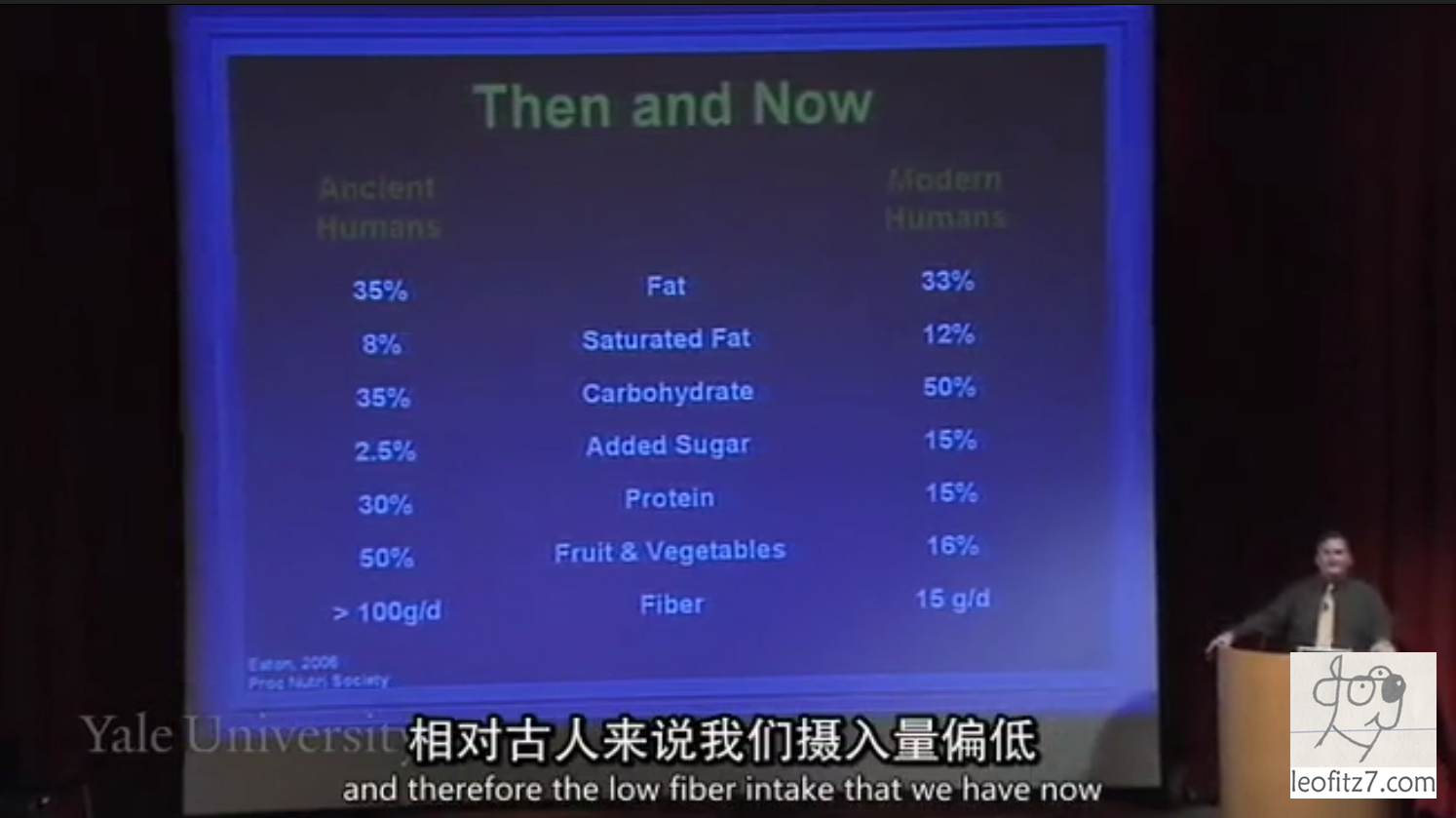前言
讲师:Professor Kelly D. Brownell
学院介绍:耶鲁大学(Yale University),旧译“耶劳大书院”,是一所坐落于美国康涅狄格州纽黑文市的私立大学,始创于1701年,今为常青藤联盟的成员之一。
课程介绍:本课程涵盖了吃的研究,因为它会影响每一个人类的健康。 主题包括口味喜好,对食物的反感,食物宗教,食物舒适性,社会仪式饮食,为粮食问题的社会规范的责任。 还审查营养不良的问题,例如,饮食失调,肥胖流行和全球影响的儿童食品广告的原因,贫穷和粮食,以及现代化环境如何影响每个人的饮食习惯。
耶鲁大学课程链接【英】:https://oyc.yale.edu/psychology/psyc-123
网易公开课链接【中/英】:https://open.163.com/newview/movie/courseintro?newurl=M6GGL5K9G
从过去到现在,饮食条件的演化
在古埃及,95%的时间用于寻找食物,剩余的5%用于建造金字塔,为法老服务。
这种农业大国的形式固然不会给个人留下太多的时间,科技方面也不会有太大的改革,娱乐就更不用提了。
如果出现虫灾,人们需要迁徙,去远处寻找食物;如果环境恶劣,人们更难寻找食物。
对比现代,我们面对的全是人工调制食品 concocted food ,而非天然食品。
对比发现,有以下不同点
对待食物的态度不同:现代人享受美食,是开心的;古代人饥不择食,是害怕死亡的食物的不稳定性不同:现代人可能晚几个小时或者更多才进食,晚一点也可以点外卖等;古代人只有对食物的担忧,即便贮存也存在及其不稳定因素。这两种不稳定性是不同的,前者是进食时间的不稳定,后者是食物供给的不稳定消耗能量不同:古代人需要时刻保持战斗状态和更多的体力来寻找制作食物,比现代人更加消耗能量
在《剑桥世界食物史》中,我们将饮食分为三个阶段
一百五十万年前
更加学会处理食物:Phase One, the million and a half years ago, in the early–in the late–Miocene and early Pleistocene phases, there was shift where people were less likely to be just going out and gathering foods from every place they could find it. To some, some planting of food, although not a lot, but also dealing with food in different ways. Instead of just eating them at the time there would be processing of it. There would be some sort of cooking, some attempt to store food for when people may have been hungry later, etc. Then going from a plant based diet to a diet that included meat. Now these were important changes because humans of course can–are omnivores (杂食动物) and can eat both plants and animals, and therefore, the ability to secure nutrients from these different sources became very appealing to humans.70万年前
更加学会寻找食物:Phase Two, in the middle Pleistocene phase–700,000 years ago. Then we got into more deliberate hunting of animals, larger species were hunted and then you started to see humans eating things like mammoth, deer, horse, bison, and reindeer. Humans banded together instead of working more as individuals and started hunting animals in groups, groups of animals hunted by groups of humans. The plant diet at this point was still quite important.1万年前
更加学会制作食物(驯养、从采集到生产):Then the Phase Three that I mentioned, the 10,000 years ago had several things occur that were very important in shaping our current situation. We have modern patterns of climate, vegetation, and fauna so the climate conditions were somewhat similar to today. Several large animal species had disappeared so people had to find other animals and so this changed from going to find animals to domesticating (驯养) animals, and shift from collection of plants to production of plants.
存在于人类身上的每一个主要的解剖学变化都可能以某种方式与人体获取和加工食物的方式有关:Virtually every major anatomical change–think about that for a minute–every major anatomical change that has existed in humans can be related in one way or another to how foods are acquired and processed by the human body.
减肥的真正原理是什么?
卡路里的消耗量 > 摄取量
为什么有的人怎么吃都不胖,有的人吃的很少却很胖呢?
机体新陈代谢:有的人代谢引擎效率高,可以将更多的能量代谢为脂肪贮存;有的人代谢引擎效率低,能量都以热量散发出去了
In that process there is a metabolic (代谢) engine at work, and some people have an efficient engine so that the calories (卡路里) in get banked in the fat, other people have an inefficient engine, that is the calories get wasted as body heat and things like that, and they tend not to gain weight.
代谢引擎效率高的人更能存储能量,也更能适应恶劣环境,但却不能适应现代发达国家的食品环境。
That efficient metabolism that banks calories is highly efficient, highly important, highly adaptable, under circumstances where food is scarce, but not efficient and not adaptive under modern food conditions in the developed world.
为什么有时候我们已经饱了,看到好吃的却还想吃呢?
因为这是天性,祖先需要不断的存储能量,你的大脑告诉了你,你以后可能会需要。
t’s because food is there. Not because you necessarily need it at the moment but your brain tells you you may need it later and so eat, eat, eat becomes the priority. Satiety, or the feeling full, having enough, being sated gets trumped by the presence of food. I just mentioned examples of that, so the organism seeks out fat, sweet, and variety and eating large amounts of food becomes a priority, at least according to the brain.
为什么脂肪比蛋白质或碳水化合物更能让机体变强?
what would it be about fat that makes it more reinforcing then protein or carbohydrate?
高热量密度 the higher caloric density
单位重量中脂肪的热量含量是蛋白质和碳水化合物的两倍,因此,脂肪才是最能维持生物的物质
The higher caloric density. Fat has twice the calories per unit weight that protein or carbohydrate sugar has, as a consequence, has the greatest survival value.
古代和现代食物对比
- 从植物获取脂肪越来越少,更多是从肉类食物中获得
- 碳水化合物由
35%升到50%,并且主要是从糖类获取 - 糖类由
2.5%升到15%,美国肥胖率高的原因有一点是因为,让食物变甜的成本比在其他国家要低,其中一部分是因为高果糖玉米糖浆,北美地区高产玉米,更适应多种环境 - 蛋白质由
30%降低到15% - 水果蔬菜由
50%降低至16% - 纤维由
>100g/d降低至15g/d,有些纤维在加工过程中流失了
为了营养和健康,我们该吃什么?
我们如何知道食物中的卡路里是多少呢?
通过燃烧,比如 弹式量热器 这类工具。通过燃烧,观察水温上升多少度。
Well what you do is you bomb the food and you use something called the bomb calorimeter that looks like this, and so essentially what you do is you put the food in this device that sits inside water. You ignite the food and burn it, and you see how many degrees centigrade the water gets raised, and that’s the measure of calories.
脂肪对应的卡路里是蛋白质、碳水化合物的2倍,所以人们更倾向于选择高脂肪的食物。Protein and carbohydrate have 4 calories per gram, per unit weight. Fat has more then twice that.
蛋白质不仅提供能量,还能为肌肉塑性,参与身体内自身蛋白的形成。
微量元素包含 维生素 、矿物质 和 水
维生素分为 脂溶性维生素 和 水溶性维生素
脂溶性维生素 一经摄取,大多数存储于肝脏的脂肪中,结果就是,身体可以随时调动这些存储,摄入过量也能引起中毒。例如VB、VC
水溶性维生素 往往立刻被身体利用,过剩会被尿液排出,例如VA、VD、VE、VK
什么帮助我们,会伤害我们
糖类
单糖包含:葡萄糖 、果糖 和 半乳糖
二糖:两种单糖的结合,麦芽糖(葡萄糖 + 葡萄糖)、 蔗糖 (葡萄糖 + 果糖)和 乳糖(葡萄糖 + 半乳糖)
多糖:复杂的碳水化合物,淀粉 、 糖原 和 纤维素
血糖与食物的关系:
【选读/点击查看】为什么有时候吃完饭会感觉很困?
原因如下:
1、食物消化需要能量
食物在胃部进行过初步消化后,会进入脾再进一步消化与吸收。饭后脾的工作量会突然增加,需要更多的气血来帮助它完成食物的消化吸收工作,这就导致了身体其他器官供血不足。而大脑的供血量如果减少,就会出现困倦的情况。
2、食欲素减少
食欲素是下丘脑分泌的一种激素。食欲素的含量与人体的睡眠有着直接的关系。当食欲素含量较低时,就容易产生犯困的情况,相反食欲素含量高时,就会变得清醒。而在饭后我们的血糖会升高,血糖浓度过高会抑制食欲素的分泌,因此饭后我们会感到困倦。
3、胰岛素大量分泌
米饭、菜类等食物中含有大量的糖分,饭后半小时左右,人体内的血糖会迅速上升,刺激身体分泌大量胰岛素后,血糖受到胰岛素抑制又会迅速下降,人就会有昏昏欲睡的感觉。同时,胰岛素还会促使钾离子进入到我们的细胞当中,使身体处于低钾状态,这也会让我们产生睡意。
解决方法:
1、饭后运动
饭后不建议做剧烈运动,可以选择室外散步来调整状态,逐步改善自己的饭后午睡生物钟,让身体慢慢适应这种改变,从而缓解饭后犯困的情况。
2、改善脾胃
每顿饭不要吃过饱,减轻脾胃的消化吸收负担。少吃辛冷食物,多吃玉米、薏米、山药等养脾胃的食物。同时,在生活中不要长期劳累过度,保持心情舒畅,避免身体疲劳情绪不佳带来的食欲不振、消化不良。
3、控制餐后血糖
一般情况下经过细加工的食物消化速度快,食用之后血糖升高速度也快,所以建议多吃燕麦、糙米、薯类等粗加工食物。另外还要适当减少淀粉类主食的摄入,也不要吃太多的蛋白质和脂肪,多吃纤维含量偏高的绿叶蔬菜。还可以搭配维持餐后血糖值的产品来控制糖分吸收。
来源:https://baijiahao.baidu.com/s?id=1634935508132614538&wfr=spider&for=pc
脂肪
对食物进行氢化(固态黄油),是在改变食物的化学性质,将 软脂酸 变为 硬脂酸,所以与软质人造黄油相比,固体人造黄油是氢化过的,使得其质地更应,但氢化过程也使得黄油更不健康。
It’s basically when you hydrogenate a food you are altering its chemical properties to take a soft fat and make it more solid. So, stick margarine compared to tub margarine. The stick margarine has been hydrogenated to make it a more solid form. In this process, the margarine becomes less healthy.
什么是反式脂肪?
他们是食品不完全氢化时,形成的不饱和脂肪。厂商初始引入反式脂肪是为了加大利润,比不加入反式脂肪而言:
增加食物的保质期:让蛋糕和独立包装食物贮存更久
It gives foods a longer shelf life, and so things like pastries and individual wrapped packages have a very long shelf life, longer then if they don’t have Trans fats.
油炸中保持稳定:使得食物口味更佳,吃起来更加美味
They tend to stay stable during deep frying and then the palatability goes up and the foods taste better, at least according to the food industry.
而剔除反式脂肪基本不会损伤商家利益,还对大众健康有好处,因此剔除也轻而易举,无损于食品业。
脂肪全是不好的吗?
其实并不是,有些脂肪反而减少癌症并发率,但,是脂肪,就会产生热量,因此,为了减少热量(卡路里),我们应该适量食用,而非过量。
You could have be consuming fat that is in itself good for heart health let’s say, or maybe protective against cancer in some ways, but it’s also adding calories to the diet, so you want to have the optimal amount of fat and not over-consume it because of the calories.
我们应该食用单不饱和脂肪:橄榄 、橄榄油 和 一些坚果
以及不饱和脂肪:玉米、大豆 、红花 、葵花 、棉籽油 以及海鲜中提取的脂肪(例如 ω-3 脂肪) ,这类脂肪能抵御多种疾病
不好的脂肪分为:饱和脂肪 和 反式脂肪。比如 肥肉 、全脂牛奶 、 人造黄油 、起酥油 、油炸食品 以及 快餐 和很多 烘烤食品
对比1900年美国与现在的死亡原因
1900年美国的主要死亡原因是肺炎,而癌症比现在少多了,因为当时的人的寿命比较短,活不到现代人那么长的时间来患上慢性疾病。
2005年的美国的主要死亡原因是心脏病、癌症、中风和慢性呼吸道疾病,而这类有一个共同特点,都是慢性疾病,而大部分都跟生活习惯有关。而食物与这些病都存在潜在关系。在05年,75%的医保费用在了慢性病上,仅心脏病和中风就花费了4480亿美元,糖尿病花费了1640亿美元。
大量食用水果和蔬菜可使心脏病普遍性降低31%,中风减少20%,其他疾病减少20%。
地中海式饮食
主要摄取 :橄榄油、谷物、水果、坚果、蔬菜、鱼以及适量的红酒
少量摄取 :肉、奶制品以及其他酒类
之所以成为地中海式饮食,是因为全球有部分地区的人们以这种饮食结构为主。它主张以 不饱和脂肪 摄入为主,多蔬菜多水果,坚果预防疾病(因为有很多有益脂肪),少量红酒降低心脏病的患病风险








